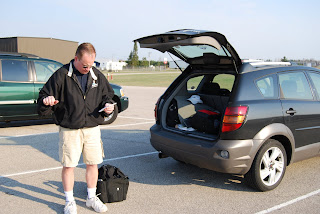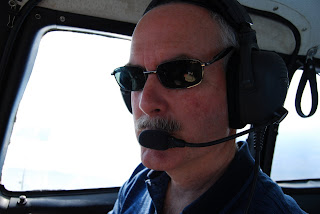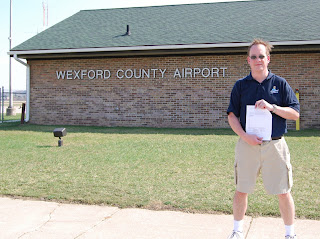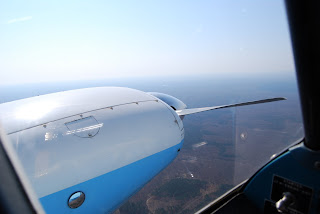Subscribe to Airspeed through iTunes or your favorite other podcatcher. Or listen online right here by clicking: http://media.libsyn.com/media/airspeed/AirspeedMultiDay2.mp3. It’s all free!
The feeling is starting to come back in my right leg and I can almost open and close my left hand again.
But it’s all worthwhile because I just added Airplane Multiengine Land to my ticket! And it doesn’t have the VFR restriction. Too cool!
I just finished the two-day accelerated multi-engine course with Tom Brady of Traverse Air. We flew at Wexford County Airport in Cadillac (KCAD) Saturday and Sunday. Two flights of 2.0 each and four instrument approaches and nine landings Saturday. Sunday was two shorter flights of 1.5 hours each and four instrument approaches and seven landings. Then the checkride Sunday afternoon with 1.2 (pilot in command!) hours, one instrument approach, and two landings.
I also got my complex endorsement as part of the process.
 Lots of studying for this. A lot to get into your head in just two days. Here’s the obligatory parking-lot engine failure drill. I think I had just stomped on the ball and was going to full forward on the levers here.
Lots of studying for this. A lot to get into your head in just two days. Here’s the obligatory parking-lot engine failure drill. I think I had just stomped on the ball and was going to full forward on the levers here.
That would be the left engine and prop and, yes, that would be the prop feathered and not turning. We did two or three full-feathered shutdowns throughout the training and the checkride. This is the second one – on the last flight with Tom. Pretty benign, actually. It’s really amazing how much drag you get with a windmilling prop that’s full forward. Other than a fair amount of rudder and some bank into the good engine, it’s pretty much like flying with both engines at lower power once you get the dead engine shut down and feathered.
 Capt. Force at the controls. This was on the way out to the practice area after an engine failure on the runway and another right after takeoff. Note the maneuver cheat sheet stuck in the headliner, ready for reference. Whereas I simply memorized the setup for other checkrides, there’s just too much information and too short a time to internalize all of the maneuver setups. Memorize the stuff that is truly memory stuff (e.g. push up, clean up, gas, pumps, verify, feather) and use checklists for the other stuff. I made a lot of outlines in law school, but the primary benefit of the outlines were actually making the outlines. It usually took only a couple of glances at the cheat sheet in the course of setting up for a given maneuver, but it was very helpful knowing that it was there.
Capt. Force at the controls. This was on the way out to the practice area after an engine failure on the runway and another right after takeoff. Note the maneuver cheat sheet stuck in the headliner, ready for reference. Whereas I simply memorized the setup for other checkrides, there’s just too much information and too short a time to internalize all of the maneuver setups. Memorize the stuff that is truly memory stuff (e.g. push up, clean up, gas, pumps, verify, feather) and use checklists for the other stuff. I made a lot of outlines in law school, but the primary benefit of the outlines were actually making the outlines. It usually took only a couple of glances at the cheat sheet in the course of setting up for a given maneuver, but it was very helpful knowing that it was there.
 Multi instructor extraordinaire Tom Brady in the right seat. Tom made the whole thing systematic and as easy to digest as possible. I’m not saying that it was easy. It wasn’t. But Tom did a great job of presenting the material in a cogent way that could be rapidly absorbed by a competent pilot who arrived prepared.
Multi instructor extraordinaire Tom Brady in the right seat. Tom made the whole thing systematic and as easy to digest as possible. I’m not saying that it was easy. It wasn’t. But Tom did a great job of presenting the material in a cogent way that could be rapidly absorbed by a competent pilot who arrived prepared.
It’s an accelerated course. In Tom’s or any other accelerated course, you’re going to have to show up having read all of the materials and having a good understanding of the theory before you get in the car to go to the airport. You should be current and proficient in single-engine aircraft and it would be a great idea to have some complex time, too. (I got my only complex time just a few days before the multi training, but even that little bit really helped.)
You’ll have to have all of your stick and rudder skills second nature because you will spend the entire weekend working on the multi-specific stuff. You must have your A-game together so that you can pay attention to the multi-specific information. There’s only enough time (and you probably only have enough energy) to learn the multi stuff. If you’re not used to holding an airspeed within five KIAS, holding an altitude within 50 feet, and otherwise doing what you need to do in a single, all of those basic things will take up bandwidth that you need for the multi. You don’t have time or energy enough to take the rust off of your single-engine flying skills while picking up the multi skills. I’m usually pretty good with airspeed, altitude, and other precision matters. But I was consistently 100-200 feet high and a little fast in the Apache until late the second day. I don’t want to think about what this weekend would have been like if I hadn’t gotten up in the Cutlass a few days before.
Lastly (at least until I get an episode out covering the whole training experience), is it just me or does everyone draw great designated examiners? Kevin Spaulding gave me a great checkride. He started with a measured and thoughtful discussion of what we were going to do and used that discussion as an outline to talk through the required information. Weight and balance, performance, the elements of Vmc, how those elements affected maneuverability, etc. Then he was relaxed and objective during the checkride.
I floated the cabin once on the instrument approach. I think I pushed at the same time there was a downdraft, but if there really wasn’t a downdraft, I’ll take the responsibility. But that was a huge float.
Unlike many of the training approaches, I nailed the heading the whole way down the stairs. I got a little busy playing with the power and that might have contributed to some of the pitch oscillations. As soon as I relaxed a little on the corrections, things got a lot smoother. Funny how that works . . .
If you’re near Traverse City or Cadillac, Michigan (or if your family can find ways in those places to amuse themselves while you’re flying your ass off for a couple of days), consider the accelerated multi-engine program at Traverse Air with Tom Brady.
Traverse Air, Inc.
294 West Silver Lake
Traverse City, Michigan 49686
231-943-4128
tbrady294@charter.net
http://www.traverseair.com/
Tom also does seaplane ratings in a PA-12! Hmmmm. I think we’re going to Traverse City for vacation this summer . . .



CONGRATS TUP!!!
…and thanks for sharing your experience with the rest of us!
One question which may be worthy of discussion…
Obviously the point of the weekend was to get you capable of passing the checkride.
…but as a gut check, how do you feel? Would you be confident taking the family up in the Apache? Would you have the confidence to pack up the spouse / 2 kids into a twin and fly back home if the opportunity had presented itself?
I only ask, because I find myself debating the accelerated vs. organic training paths myself as I consider IFR / COM / MEL / CFI tickets (hopefully!) in my future.
You raise an excellent point. I actually did not expect to be a fully-competent multi guy when I finished. As Kent of The Pilotcast said when I asked him how competent I should expect to become in the program, Kent said, “It’ll get you through the checkride, but it won’t make you a multi-engine pilot.”
I don’t consider myself a multi-engine pilot in the sense that I would expect to need more seasoning (10-20 hours) before being genuinely comfortable in the airplane. As an example, we all know that a person can become PTS-compliant for the private certificate in a lot less than 35 or 40 hours, but the time requirement also allows the student to see stuff. To have things happen to them. It really is “experience.” The same thing applies to multi-engine flying. Although I’m a grown-up now with almost 200 hours grand total, I’d feel more confident after having gotten the rating a little moist with some more dual.
Further, this rating’s purpose is to qualify me to train for the SIC type rating in the DC-3 (now scheduled for May 23-25 in Griffin, Georgia). It’s a step on the road to the grand adventure in May.
But here’s the thing. I surprised myself a little. If the wife and kids had shown up after the checkride and asked me to put them in the Apache and go around the patch or on a short cross-country to, say, Traverse City, I would have felt capable of doing that. Even more so than in a single. (I really like the idea of an extra engine.) Bear in mind that the winds were more or less 090 (good for both KCAD (07-25) and KTVC (10-28)) with few at 12,000 and 8+ SM visibility and minor convective activity.
Would I launch IFR (even though I got cleared during the checkride with no VFR limitation)? Hell, no! I presently won’t launch IFR single pilot in a single (just a personal limitation based on proficiency). And I don’t think I’d launch IFR in IMC without good VMC nearby in the Apache without about 10 more failed-engine approaches by which to judge my proficiency.
Is that helpful? Is it even responsive? I guess it is. Long story short, I would have felt competent to take the wife and kids up right after the checkride – within limits.
It all really comes down to how much prep you do. Flight training is about bandwidth packing. Remember your first flight under the hood? It took about 90% of your available bandwidth just to fly straight and level. Try to tune a radio, and the instructor is grabbing for the controls and cursing. But it gets better until you can pack all normal operations into about 80% of your available bandwidth.
If you show up with all of the book learning internalized enough so that all of your bandwidth is available for the sights, sounds, and kinesthetic sensations of the actual multi-engine flying that you’re learing, it wouldn’t surprise me to find you feeling pretty confident after an accelerated course.